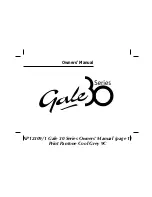
LP3-500 Owner’s Manual | 3
INTRODUCTION
Your Reo-Pure System has been designed to produce quality
water for a variety of applications. We are confident that you
will find Reo-Pure Systems provide quick and simple
installation, hassle-free maintenance, and years of reliable and
trouble free operation.
Reo-Pure
Systems
incorporate
years
of
engineering
experience, dedicated workmanship, and quality manufactured
components. Each system is built with pride and is factory
tested for superior performance.
As with all products, the customer has the responsibility to
ensure that the Reo-Pure System is operated under proper
conditions and within design limitations. All installation,
startup and maintenance instructions must be followed
carefully.
HOW REVERSE OSMOSIS WORKS
Reverse osmosis is a separation process in which water is
forced under pressure through a membrane in the opposite
direction from normal. The membrane allows water to pass
through and blocks or hinders the passage of dissolved
substances and suspended particles. This process reduces the
dissolved salts, minerals, and suspended particles, while
improving the taste, odor, and clarity of the water. The process
is further enhanced by allowing the feed water to continuously
pass over the surface of the membrane, sweeping away the
concentrated salts, minerals and suspended particles.
The Reo-Pure membrane element divides the feed water into
two streams: product water (permeate) which is now purer
than before, and is the desired result; and concentrate water
(reject or drain, plus recirculation) which carries the
concentrated dissolved salts, minerals, and suspended particles
that were rejected by the membrane element down the drain.
DEFINITION OF TERMS
Feed Water
– The incoming water to be processed by the
Reo-Pure System.
Product Water (Permeate)
– The portion of the feed water
that has passed through the membrane element. It is the
desired result of a Reo-Pure System.
Concentrate Water (Reject or drain water, plus
recirculation)
– Used to describe the portion of feed water
that has flowed across the membrane (not through), and has
not been converted to product water. This water now contains
a higher concentrate of dissolved solids and may also contain
organic matter and suspended particles rejected by the
membrane. The concentrate is then split into two streams,
reject and recirculation. The recirculated water is mixed with
the feed water on the inlet side of the pump. The reject water
is sent down the drain. This design is used as a way to
minimize the amount of water sent to drain.
Recovery
– The percentage of feed water that becomes
product water. The recovery rate is determined by the number
of gallons (or liters) of product water divided by the total
gallons (or liters) of feed water, and multiplied by 100.
Percent Rejection
– The percentage of dissolved solids in the
feed water that does not pass through the membrane. The
membrane prevents passage of dissolved solids and other
contaminants into the product water.
Conductivity
– The property of a substance to conduct or
transmit electricity. The unit of measure is in mhos and is
commonly used to determine the purity or quality of water. In
the water treatment industry, it is often converted to PPM TDS
(Parts Per Million Total Dissolved Solids).
FACTORS AFFECTING SYSTEM
OPERATION AND PERFORMANCE
Feed Water Temperature
– The volume of product water
increases with higher feed water temperatures, and decreases
with lower feed water temperatures. Temperatures below 35°F
could crack the membrane element, and temperatures
exceeding 90°F may cause rapid deterioration. The
recommended range is between 45°F and 90°F.
Feed Water Pressure
– The recommended range is between
40 PSI and 85 PSI. This is the most common range of
municipal water supplies.
Hydrolysis
– The natural chemical breakdown of membrane
elements when in contact with water. This breakdown is
accelerated when the water temperature is above 90°F, when
the pH is not within the tolerable range, or when hydrogen
sulfide is present. Refer to the System Operating
Specifications section of this manual. Additional pre-treatment
may be required in these cases.
Bacteria
– R.O. Systems may be exposed to bacteria if
operated intermittently. Following a prolonged shutdown or
storage period, the system should be sanitized. Refer to the
section in this manual regarding sanitization.
Fouling or Surface Coating of the Membrane Element
–
Fouling is a common problem with membrane elements as a
result of salts, hardness, iron, etc. collecting on the membrane
surface. The pores and channels of the membrane element
become plugged reducing the water production rate. Pre-
treatment equipment, such as a water softener, iron filter, or
activated carbon filter will reduce membrane element fouling
and extend its life.
Содержание LP3 Series
Страница 1: ...LP3 500 Owner s Manual 0 LP3500 03172015 ...
Страница 22: ...LP3 500 Owner s Manual 21 LP3 SERIES SYSTEM FLOW DIAGRAM ...
Страница 23: ...LP3 500 Owner s Manual 22 SYSTEM WIRING SCHEMATIC ...
Страница 24: ...LP3 500 Owner s Manual 23 ...





































